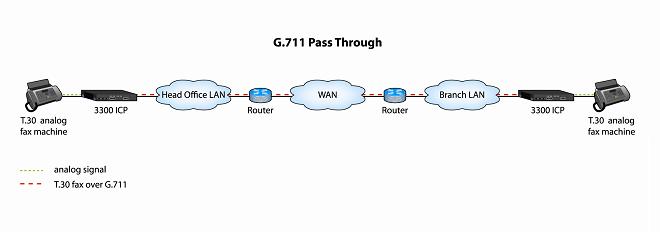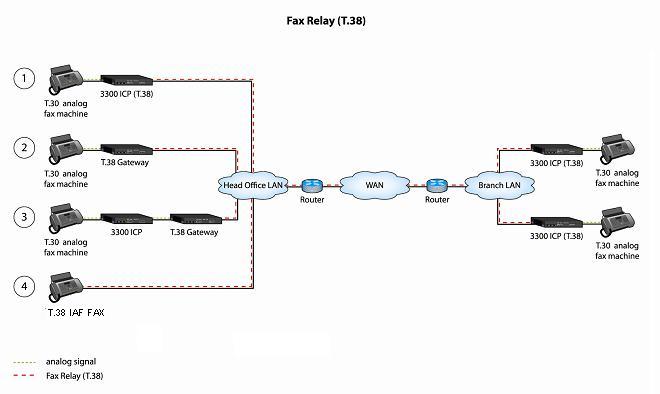
This feature supports real-time, Group 3 facsimile (FAX) communication over IP networks using FAX Relay (T.38 standard protocol). FAX Relay (T.38) allows you to transmit and receive facsimile over IP trunks between FAX machines on 3300 ICP (Release 9.0 or later) systems.
You can configure the 3300 ICP network to allow facsimile to be sent over the
PSTN using analog signalling
IP network using G.711 pass-through, or
IP network using FAX Relay (T.38)
The following illustrations show simple examples of these configurations. It is possible to configure network configurations that are much more complicated than the configurations detailed below.
In this configuration, FAX data is sent using analog signalling. The system connects to the PSTN via LS, PRI, or T1 trunks. With this method, it is more expensive to send faxes long distances over the PSTN than it is to send them over the IP network.

This method uses T.30 protocol with G.711 pass-through to send FAX over IP trunks using the LAN and WAN. The 3300 ICP systems in the network must be running Release 7.0 or later.

This method has the following advantages:
allows you to send faxes between 3300 ICP systems over the IP network
reduces the cost of sending long-distance faxes because the data is sent over the IP network and not the PSTN
However, this method has the following disadvantages:
LAN and WAN must be engineered to meet the LAN quality guidelines specified in the 3300 ICP Engineering Guidelines.
Voice packets carrying fax on the network cannot be compressed.
Quality and performance of fax transmission using G.711 pass through is inferior to the quality and performance provided by FAX Relay (T.38) protocol, especially over WAN links because the likelihood of network issues is higher.
FAX Relay (T.38) is the preferred method because the
quality and performance of FAX transmission is superior to that of the G.711 pass though method, especially over WAN links
LAN and WAN does not have to be engineered specifically to support this method of FAX transmission.
The following diagram illustrates four different ways that FAX Relay (T.38) can be employed to support fax transmission:
FAX machine connected to a T.38 protocol enabled 3300 ICP
FAX call transferred by 3300 ICP to a T.38 protocol enabled gateway
FAX machine connected directly to a T.38 protocol enabled gateway
Internet Aware FAX (IAF) machine with built in T.38 gateway functionality

